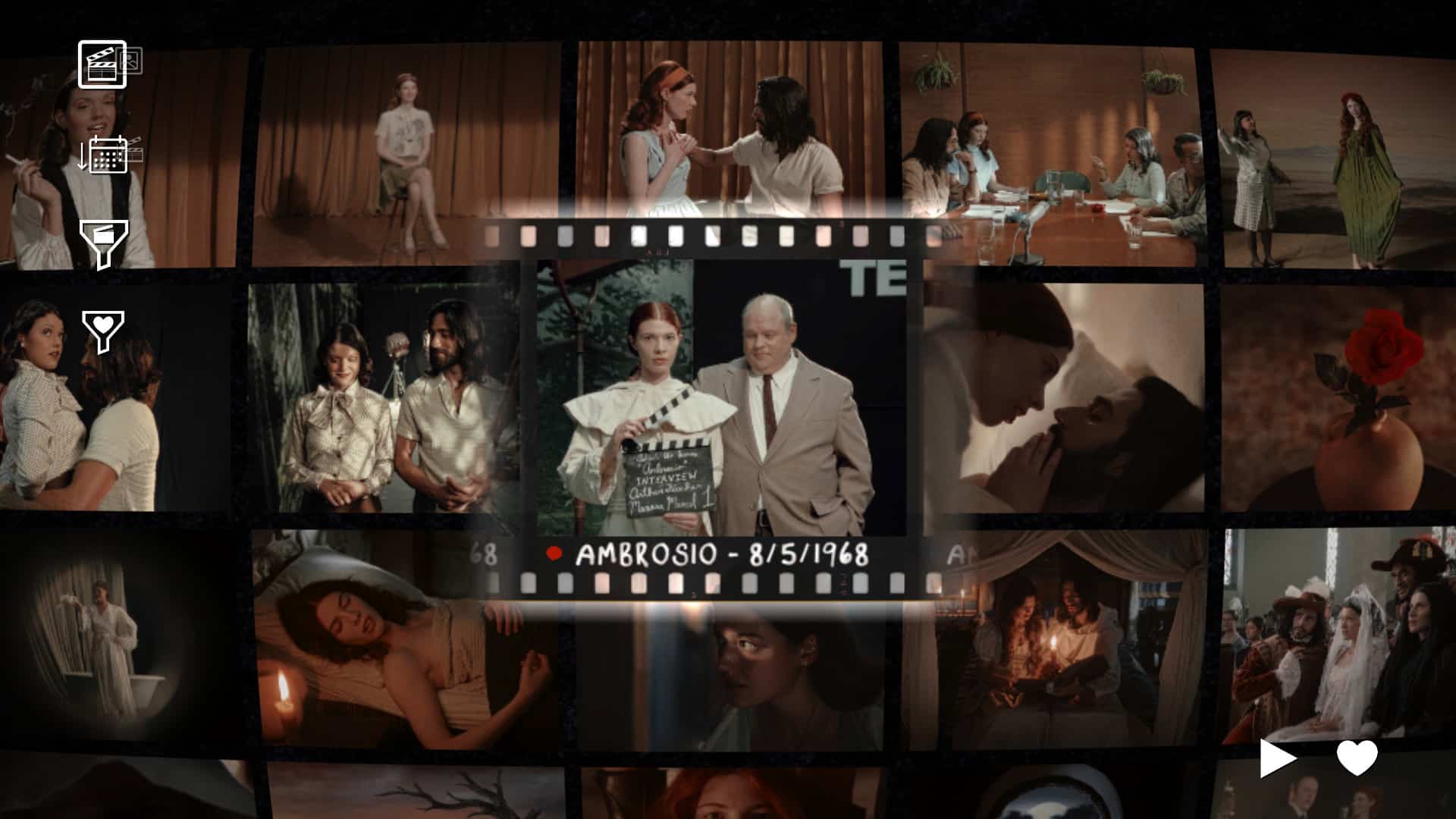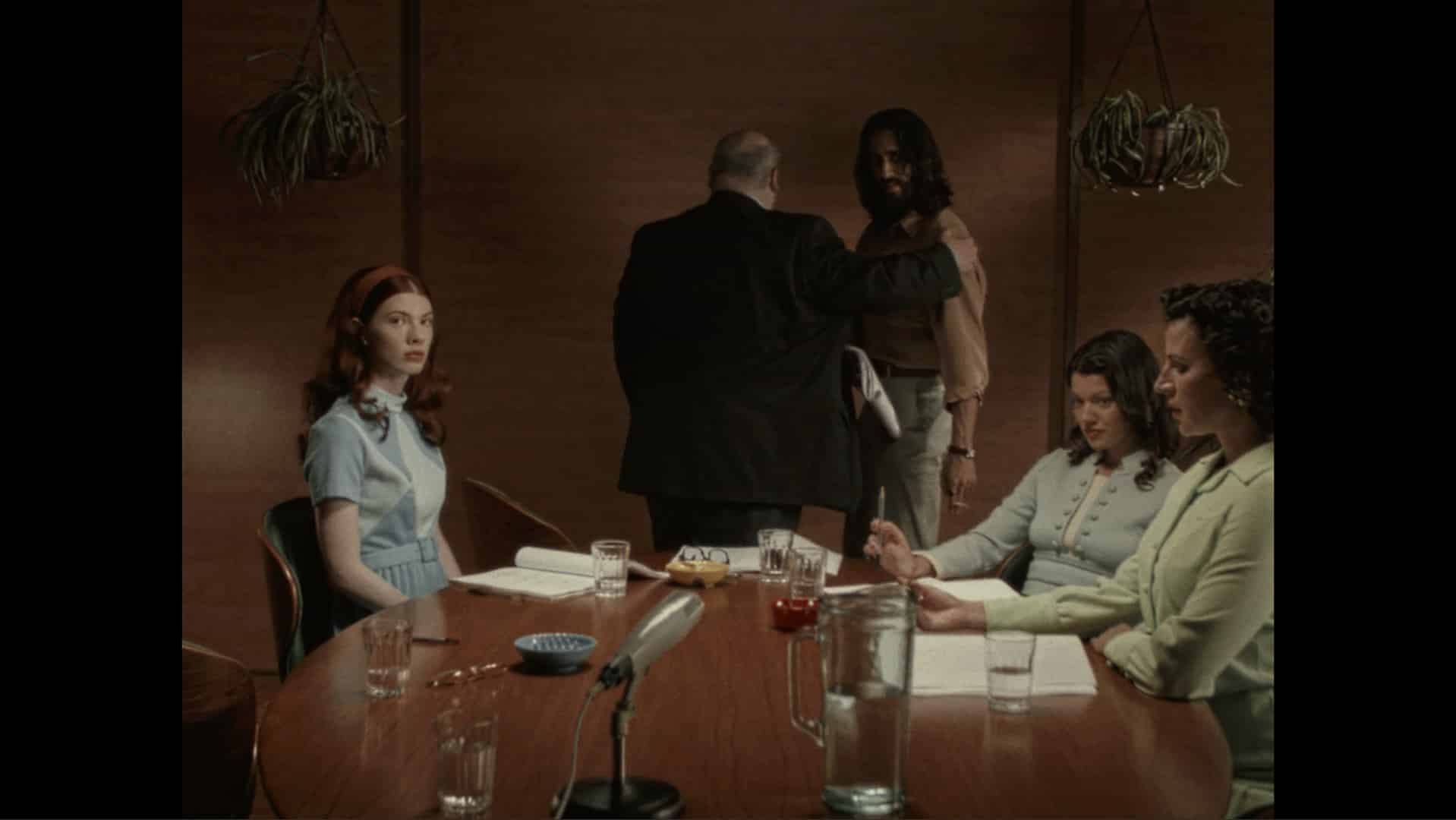This discussion about the application of critical thinking to the game Immortality contains very minor spoilers.
Sam Barlow’s and Half Mermaid’s Immortality is many things. It’s an original fusion of cinema and gaming, putting the player in charge of a virtual Moviola machine in order to scrub footage from three unreleased films starring the missing actress Marissa Marcel. It’s a demanding experiment in ergodic storytelling, requiring considerable effort from the player to piece together its non-linear, layered, and satisfyingly unsettling narrative. It’s a disconcerting commentary on the role of female leads across three eras of cinema (even if two of Marcel’s films are separated by only two years). And perhaps less obviously, Immortality is a fascinating insight into our own critical thinking.
The Moviola mechanic relies on full-motion video from one of Immortality’s 202 clips, distributed across three films and some of their behind-the-scenes footage, interviews, backstage parties, and other, far stranger, pieces of lost history. These can be played and rewound at different speeds, including frame by frame for maximum granularity. At any point the action can be stopped and an object selected as the focal point of a match cut — an attempt to find another frame anywhere amongst the 202 clips that matches as closely as possible the composition of the paused footage. In this way new clips are uncovered and some unexpected themes revealed. It’s film restoration by way of Blade Runner’s Esper machine, if you will.
The clips are added to a library that can be sorted in order of filming or in the chronology of the films, while the scenes used for the match cuts compose a separate repository of images. This repository is bespoke to each player — a kind of diary of their route through Immortality. By extension, it’s a kind of diary of the reasoning they applied to link one scene to the next.

Immortality throws you in at the deep end: Your first several dozen match cuts can follow whatever route you wish. You may choose to cut wildly from one scene to the next, picking objects at random and seeing where they take you. You may, if you are like me, choose to rewind each scene you cut to and watch it in full before cutting again while you attempt to hold other objects of interest from the scene in your memory. You may focus on key actors, on crew members, on objects of ritual, on fruit, bags, shoes, tables and chairs, and so on.
But in the end we all come to the same set of credits. And so, despite handing us a gameplay mechanic that initially seems to accommodate any way of reasoning, it is interesting to think about the common factors that Immortality relies on in our critical thinking to get us through its runtime — to look for commonalities in those match-cut repositories.
In the most reductive analysis, Immortality is a game that relies on pattern recognition. There are the narrative arcs of Immortality’s three films: Ambrosio, Minsky, and Two of Everything. There is the secret narrative arc behind the game’s core question: What happened to Marissa Marcel? (And for that matter, what happened to some of her key co-stars and co-creators?) But there are also multiple smaller stories and relationships, like the hilarious but ultimately toxic meltdown from a veteran actor too uncomfortable with Minsky’s edgy script, or director Arthur Fischer’s overbearing personality on the set of Ambrosio. And there are the more abstract thematic associations among objects like weapons, crosses, flames, and others.

These are patterns that our brains are hard-wired to look for. Given enough scenes from Ambrosio, for example, even if they are match cut at random and from very different parts of the film, we automatically start to look for an overarching narrative to tie them together. If we have the beginning and the end, we hypothesize the middle and might look for a match cut to get us there. If that second act proves to be different from what we supposed, our hypothesis is dismissed and a new one is put in its place — a kind of scientific method applied to fiction.
It is for this reason that Immortality’s secret story, which in the final account proves to be much more biblical in scope than simply what happened to Marissa Marcel, works as well as it does. That tale is unveiled gradually, scene by creepy hidden scene, first through suggestions or dialogue that make little sense in isolation and later through more explicit exposition. The player’s reasoning now races to fill in the blanks, as it is by this point trained to piece together the stories of Ambrosio, Minsky, and Two of Everything, which are each in their own way thematically linked to the hidden narrative, and each more complex than the last.
Immortality’s lack of full clarity about its story works as well as it does precisely because the game continuously primes and trains the player for interpretation. If anything, it would be jarring to have the narrator step in with a definitive version of events.
The game employs other tricks too, sometimes deliberately subverting the way we might typically think in order to unsettle, highlight something, and ultimately move the story along. For example, our innate ability to quickly recognize and remember faces clashes with scenes where Immortality match cuts between two very different faces. These are so jarring as to force the player to reflect on what they are experiencing — to hypothesize about the story, if they don’t already have a dozen different hypotheses competing for attention.

In the latter third, particularly after the credits roll, the match-cut mechanic shows its limitations. It becomes increasingly difficult to find the remaining scenes; the act of matching objects starts to feel more like random stabs in the dark or point-and-click busywork than a considered route of investigation. Yet even here there are interesting lessons about the way we think, as we are forced to consider objects that might have been overlooked on the first few passes through a scene.
In particular, it’s an insight into salience and the availability bias — the idea that certain objects in an environment are more prominent to us than others and that certain memories, concepts, or examples are more available to recall than others. It is for this reason, for instance, that what seemed to me like the innocuous placement of apples in Two of Everything only late on became a key tool for match cutting and an important addition to the thematic vocabulary I’d drawn up for the game.
Whatever else it might be, then, Immortality is a puzzle for the player. Like other puzzles, it has something to show about player reasoning. But unlike other puzzles, because it is really unlike them in every respect, what Immortality has to show is unique — a singular experiment in player engagement.






Published: Sep 21, 2022 11:00 am